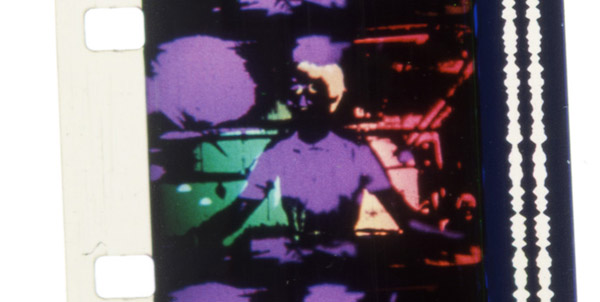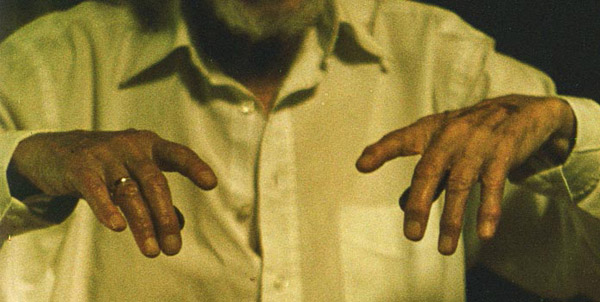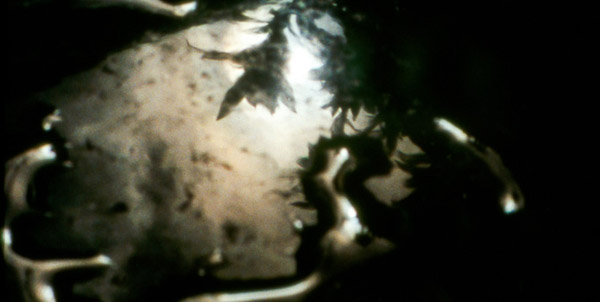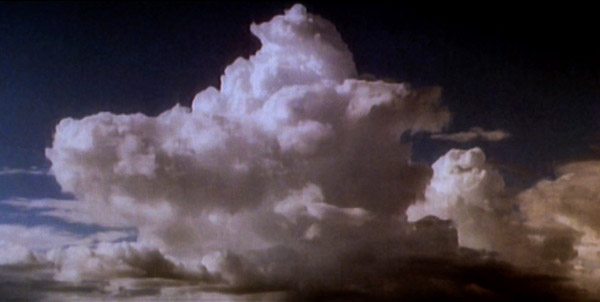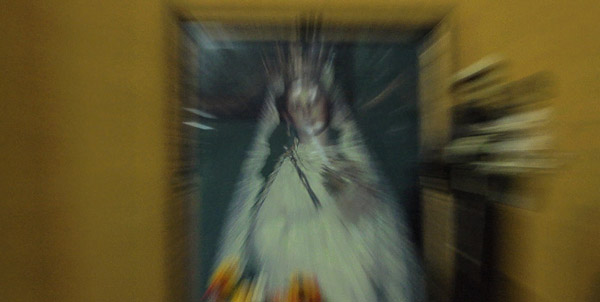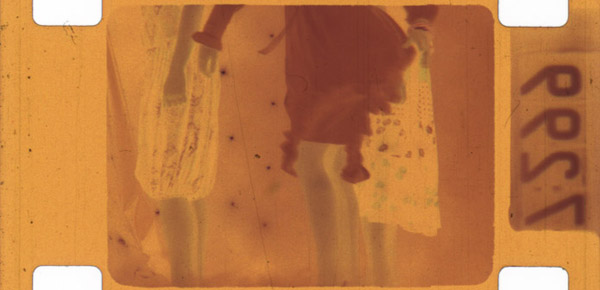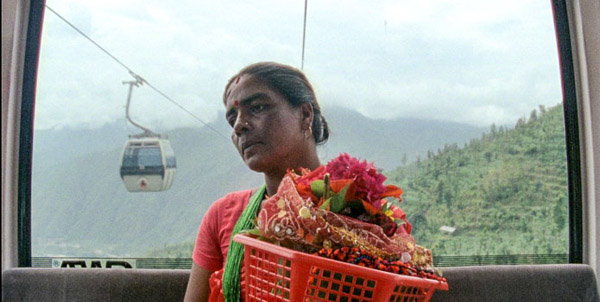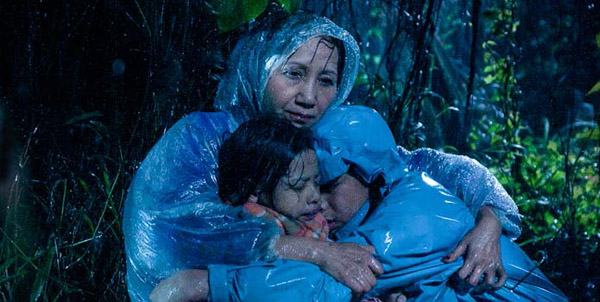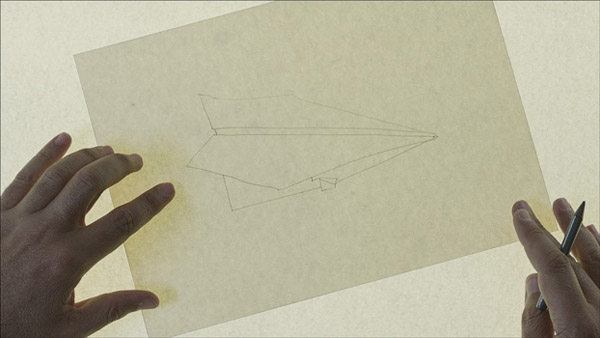With a fifth round of titles announced today, the lineup for the 2013 edition of Toronto International Film Festival (September 5 through 15) is nearing completion. Today’s batch is huge, so we’re breaking it up a bit. Earlier: Galas and Special Presentations; Midnight Madness; TIFF Docs, Vanguard, City to City, and TIFF Cinematheque; and Canadian films.
Here’s the Wavelengths program, with descriptions from the festival, plus occasional notes…
Basma Alsharif’s Farther Than the Eye Can See. “An essayistic exploration of statelessness is conveyed through this visually gripping and astutely constructed tale of a mass exodus of Palestinians from Jerusalem, recounted over a dense, stroboscopic cityscape.”
Kenneth Anger’s Airships. “Anger exhumes newsreel footage of mighty dirigibles hovering ominously in the sky, the filmmaker’s characteristic fusion of magick, symbolism, mystery and myth imbuing the already incredible footage with an eerie, supernatural quality.”
Wojciech Bakowski’s Dry Standpipe. “A startlingly raw interlaced video collage by celebrated Polish artist, musician and poet Wojciech Bakowski.”
Robert Beavers’s Listening to the Space in My Room. “A moving testament to existences past and present, this portrait of a space once inhabited by filmmaker Robert Beavers adheres to a precise, yet enigmatic sound-image construction that carries rare emotional weight.”
Stephen Broomer’s Pepper’s Ghost. “In a prolonged expression of demystified mystification, an office formerly used for observation studies is transformed into a tunnel of performative, transfixing illusionism.”
Ali Cherri’s The Disquiet. “Presented as an investigation of Lebanon’s history of earthquakes, Ali Cherri’s short film is a captivating poetic meditation on contemporary representations of catastrophe, whether the collapse of a bridge, or an empire.”
Sarah J. Christman’s Gowanus Canal. “Christman continues her 16mm ecological studies with Gowanus Canal, in which contamination and compression of refuse intimate a stultifying state for one of the most polluted bodies of water in the United States.”
Nick Collins’s Trissákia 3. “The beauty of the ruins of a thirteenth-century Greek church is heightened by supernal light and shadow play.”
Mati Diop‘s A Thousand Suns. “Diop fuses documentary and fantasy in this hauntingly beautiful portrait of Magaye Niang, star of her uncle Djibril Diop Mambéty’s 1972 classic Touki-Bouki.”
Tiane Doan na Champassak and Jean Dubrel’s Natpwe, the feast of the spirits. “An immersive, sooty black-and-white documentary about an annual Burmese trance ritual, with echoes of Jean Rouch and David Lynch.”
Nathaniel Dorsky’s Spring and Song. “Spring conjures an abundant return of light and a retreat into nature so dense and rich that the film itself becomes a sort of wondrous garden-verdant, incandescent, with startling bursts of color.” And: “Shot in San Francisco from autumn of last year through the winter solstice, Nathaniel Dorsky’s Song evinces a cool, mysterious tone as it captures the pulse (supernal at 18fps) of the city.”
Helga Fanderl’s Constellations. “Observing the natural world with a profound curiosity, a patient gaze, and an extraordinary ability to capture visual patterns and textures, Super 8 artist Helga Fanderl invites us to bask in the beauty of a fugitive present with this latest collection of 16mm blow-ups.”
Philipp Fleischmann’s Main Hall. “A 35mm reflexive deconstruction of the main exhibition hall of the Vienna Secession using nineteen specially designed cameras to kinetically record its space and architecture, Main Hall adds a purely cinematographic gesture to the history of this formidable White Cube.”
Miguel Gomes‘s Redemption. “Gomes (Tabu) muses with characteristic humor and melancholia upon small-scale, perversely prescient moments of human fallibility in this witty and affecting found-footage film.”
Peter Hutton’s Three Landscapes. “Shot on 16mm, this wondrous silent film study from avant-garde master Peter Hutton (At Sea) observes human movement across three distinct landscapes: Detroit, along the Hudson River Valley and in the Dallol Depression in Ethiopia.”
Shambhavi Kaul’s Mount Song. “A strange yet familiar sense of place dominates Shambhavi Kaul’s deceptively disorienting and visually entrancing Mount Song. As a wild, foreboding gust courses through the night, a subdued elegance is brought forth from past cinema spectacles, whose generic, albeit highly suggestive set constructions remain lodged in our imaginary.”
Chris Kennedy’s Brimstone Line. “Three freestanding grids placed along the Credit River in rural Ontario (reminiscent of the Dürer Grid used by Renaissance draughtsmen to achieve accurate proportions) become devices through which the stationary camera frames the landscape and creates perspective.”
Nina Könnemann’s Bann. “An uncanny urbanscape is clandestinely observed, revealing a sense of alienation, self-consciousness, perhaps even shame.”
Andrew Lampert’s El Adios Largos. “A speculative restoration of Robert Altman’s The Long Goodbye, El Adios Largos is at once an uncanny aesthetic experience and a playful exploration of the philosophical conundrums involved for those working to preserve film history for generations to come.”
Angela Ricci Lucchi and Yervant Gianikian’s Pays Barbare. “Milan-based duo Yervant Gianikian and Angela Ricci Lucchi create an astonishing work of militant poetry with this found-footage chronicle of Mussolini’s brutal invasion of Ethiopia.”
Raya Martin and Mark Peranson’s La última película. “Lauded Filipino auteur Raya Martin (Independencia) and Canadian critic-filmmaker Mark Peranson collaborate with Alex Ross Perry (The Color Wheel) and frequent Nicolás Pereda star Gabino Rodriguez for this feverish, aesthetically startling re-imagining of Dennis Hopper’s notorious cult classic The Last Movie.”
Carlos Motta’s Nefandus. “An evocative essay on pre-conquest homoeroticism, Nefandus searches for traces of untold stories and stigmatized historical accounts.”
Tomonari Nishikawa’s 45 7 Broadway. “The frenzied pace and conflicting rhythms of Times Square are captured through a dense tapestry of light and space achieved through rigorous optical printing and rich, eye-popping color overlays.”
Rithy Panh’s The Missing Picture. “Panh (S21: The Khmer Rouge Killing Machine) won the Un Certain Regard prize at this year’s Cannes Film Festival for this startlingly original work, which uses handmade clay figurines and detailed dioramas to recount the ravages that Pol Pot’s regime visited upon the people of Cambodia following the communist victory in 1975.” See the reviews from Cannes.
Cristi Puiu‘s Three Interpretation Exercises. “Puiu (The Death of Mr. Lazarescu, Aurora) transforms what began as an intensive three-week acting workshop into a deeply intelligent, wryly amusing, and compulsively watchable cinematic treatise worthy of Rohmer’s Moral Tales.”
Luther Price’s Pop Takes. “A terrific thrift-store find is transformed into a Warholian catwalk, upon which twirling women and jaunty men sashay toward us with decadent, late-seventies zeal.”
Lucy Raven’s RP31. “An animation made from 31 film projection test patterns and calibration charts. Used in the motion picture industry to test for focus, aperture, field steadiness, framing, these patterns are images you’re not supposed to see, which are made to make you see better.”
David Rimmer’s Variations on a Cellophane Wrapper. “Newly restored by the Academy Film Archive, David Rimmer’s 1970 avant-garde classic takes a single film fragment of a factory worker unraveling a sheet of cellophane, and alters it through a mesmerizing series of spectral apparitions and alchemical and sonic permutations.”
Ben Rivers and Ben Russell‘s A Spell to Ward Off the Darkness. “The first feature-film collaboration between celebrated artist-filmmakers Ben Rivers (Two Years at Sea) and Ben Russell (Let Each One Go Where He May) follows a nameless protagonist (played by musician Robert AA Lowe) as he explores three very different existential options: as a member of a commune on a small Estonian island; living alone in the breathtaking wilds of northern Finland; and fronting a neo-pagan black metal band in Norway.” See Adam Cook‘s interview with Rivers and Russell in the Notebook.
João Pedro Rodrigues’s The King’s Body. “Rodrigues (To Die Like a Man) enlists a group of musclemen for this brilliant and idiosyncratic inquiry into his country’s centuries-old fascination with the legendary king Afonso Henriques.”
Christophe M. Saber, Ruben Glauser, and Max Idje’s Man in Motion, 2012. “Constructed from the delays in real-time video feedback and recorded onto black-and-white 16mm, this film summons both Muybridge and Duchamp through a hallucinatory mise-en-abyme.”
Hannes Schüpbach’s Instants. “The latest 16mm film by acclaimed artist-filmmaker Hannes Schüpbach explores with exquisite precision the nature of spontaneous time and lasting memory.”
Albert Serra’s Story of My Death. “Following his radical (re-)interpretations of Cervantes’s Don Quixote (Honor de Cavalleria) and the Biblical tale of the Three Kings (Birdsong), celebrated Catalan filmmaker Albert Serra imagines an encounter between two other legendary figures of world literature—Casanova and Count Dracula—in this deliciously eccentric and exquisitely detailed riff on the historical costume drama.”
Stephanie Spray and Pacho Velez’s Manakamana. “The makers of last year’s Festival hit Leviathan served as producers on this astounding sensorial stunner that takes us on a state-of-the-art cable car up and down one of the vast, awe-inspiring Trisuli valleys in Nepal, where the world-famous Manakamana Temple attracts pilgrims and tourists from the world over.” See Adam Cook‘s review in the Notebook.
Scott Stark’s The Realist. “A dizzying stereoscopic mannequin melodrama, this entrancing romp conjures retail worlds both familiar and strange, in which chiselled mannequins may in fact be communing with each other amid an overwhelming array of apparel. Consumerist critique, spellbinding operatic fantasy, or both?”
Jean-Marie Straub‘s Un Conte de Michel de Montaigne. “Straub continues his exploration of classic texts with this ‘collaboration’ with the great 16th-century writer of the Essais.”
Caroline Strubbe’s I’m the same I’m an other. “A road movie. An unorthodox crime story. Portrait of an unlikely companionship. Belgian director Caroline Strubbe’s uniquely crafted second feature combines all of these to tell the moving story of a man and a child in mourning as they journey through Western Europe.”
Naoko Tasaka’s Flower. “A sphinx-like allegory that plumbs the depths of physical and metaphorical surfaces, Flower hovers between straightforward narration and sublimated abstraction.”
Tsai Ming-liang’s Stray Dogs. “Imbued with mystery, sly humour, and an enormous heart, the latest film from visionary director Tsai Ming-liang (The Wayward Cloud) links together a series of sumptuously composed scenes that tell the story of a broken family living on the margins of Taipei society.”
Joao Viana’s The Battle of Tabatô. “A father arrives in Tabatô, Guinea-Bissau to give his daughter away at her wedding, but must also make peace with memories of his violent past there, in first-time feature director João Viana’s meditation on good and evil.”
Wang Bing’s ‘Til Madness Do Us Part. “Wang Bing casts an understanding and non-judgmental eye on the inmates of a decrepit Chinese mental hospital in this eloquent and emotionally impactful documentary.”
Ben Wheatley’s A Field in England. “A single muddy West Country field provides the setting for this brilliantly bizarre English Civil War drama and psychedelic horror film from genre-fusing cult director Ben Wheatley (Kill List, Sightseers), which features a group of deserters, a necromancer, psychoactive plants and buried treasure.” See last month’s reviews.
Akram Zaatari’s Letter to a Refusing Pilot. “Lebanese artist-filmmaker Zaatari conducts both an investigation and a stirring tribute to an act of resistance (or forbearance) that marked his childhood memories: the refusal of an Israeli pilot to bomb a boys’ high school in south Lebanon in 1982.”
Ramon Zürcher’s The Strange Little Cat. “Loosely inspired by Kafka’s The Metamorphosis, this enchanting, minimalist gem by first-time feature director Ramon Zurcher has won admiring comparisons to the work of such masters as Jacques Tati, Robert Bresson and Chantal Akerman.”
For news and tips throughout the day every day, follow @KeyframeDaily on Twitter and/or the RSS feed. Get Keyframe Daily in your inbox by signing in at fandor.com/daily.

